Search the Special Collections and Archives Portal
Search Results
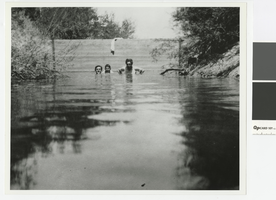
Photograph of Floyd Francis and Jake Beckley in the swimming hole on the Von Tobel and Beckley property, circa 1910
Date
Archival Collection
Description
Floyd Francis (center), Jake Beckley (right), and unidentified man in the "Old Swimming Hole" on the Von Tobel and Beckley property
Transcribed Notes: Transcribed from photo sleeve: "Floyd Francis (center), Jake Beckley (right), and unidentified man (on left) in an old swimming hole formed on the property of Von Tobel and Beckley."; Transcribed background history: "Early Las Vegas History by Florence Lee Jones, April 1969: Creating their own oasis in the Las Vegas Valley was the hobby of the late Ed Von Tobel, Sr., and his partner, the late Jake Beckley, when they came to Las Vegas in 1905 as gay young bachelors. At their ranch in Paradise Valley, where they owned the 120 acres now comprising the Sierra Vista Ranchos, exclusive residential area, they used the facilities at hand to form an 'old swimming hole.' From one of the three wells they drilled they diverted the free-flowing water into a nearby creek bed, built a cement dam to contain the water, and had their own pleasure resort. In this picture, from left, an unidentified man; Floyd Francis, early employee of the Von Tobel Lumber Company; and Jake Beckley, a partner in the fi
Image
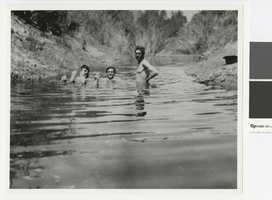
Photograph of Floyd Francis, Jake Beckley, and friend in the swimming hole on the Von Tobel and Beckley property, circa 1910
Date
Archival Collection
Description
Floyd Francis, an unidentified man, and Jake Beckley in the "old swimming hole" on the Von Tobel and Beckley property
Transcribed Notes: Transcribed from photo sleeve: "Another view of Floyd Francis, an unidentified man and Jake Beckley in the swimming hole on the property in Paradise Valley owned by Von Tobel and Beckley."; Transcribed from background history: "Early Las Vegas History by Florence Lee Jones, April 1969: In the years immediately after the auction of lots and the start of Las Vegas in 1905, a swimming pool was unknown in the area - but the late Ed Von Tobel, Sr., and his partner in the lumber business, Jake Beckley, solved that problem, as this picture shows. Von Tobel took this picture, showing from left Floyd Francis, who worked for more than 20 years at the Von Tobel Lumber Company; an unidentified man; and at right, Beckley. At their 120-acre ranch in Paradise Valley, which was a week-end retreat for the partners, they drilled three wells so they could irrigate their fruit orchard and truck garden. One of the wells had such a heavy flow that they dammed up a natural wash and created a swimming pool, a
Image
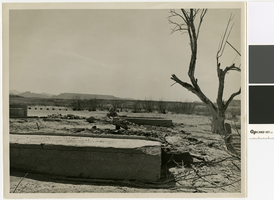
Photograph of the remains of Mary Gibson's home in St. Thomas, 1945
Date
Archival Collection
Description
Remains of Mary Gibson's home in St. Thomas, looking toward the Valley of Fire
Transcribed Notes: Transcribed from photo sleeve: "Looking westward toward the Valley of Fire. In the immediate foreground are the remains of the home of Mrs. Mary E. Gibson, widow of Moses Gibson, a farmer. The smaller foundation slightly further on and to the right is the granary. Farther to the left is the foundation of the former home of Robert Bunker, now living in Las Vegas. Robert Bunker's nephew is one of Nevada's current Congressmen. A bit further on in the picture, one can see the remains of the house once occupied by ''Rock'' Whitmore, who now lives in Overton. Whitmore is the son-in-law of Mr. and Mrs. John F. Perkins, pioneer (1903). Residents of St. Thomas, the Perkins family now lives in Overton. Mrs. Perkins' father was Harry Gentry, an Englishman, and one of the earliest settlers in St. Thomas. Harry Gentry [Sr.] built the first modern building, a hotel, in St. Thomas. He died in St. Thomas in 1925 and his body was disinterred in 1934, when the flood waters of Lake Mead began to cover St. Thomas."
Image
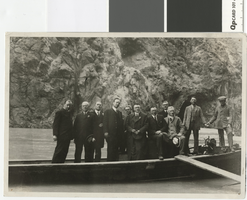
Photograph of a congressional delegation visiting the Hoover Dam site, March 13, 1923
Date
Archival Collection
Description
Congressional delegation visiting the Hoover Dam site. Photo sleeve includes information from responses to Las Vegas Review-Journal newspaper "Help Us Write History" requesting photograph identification. Identified individuals: James Scrugham (1st man on the left) was Governor of Nevada at the time, but more names than actual people in the photograph are listed, so all potentially identified names have been included. Governor James G. Scrugham hosting a delegation from the United States Congress, visiting the site of the proposed Boulder Dam (now Hoover Dam) in 1923. The photo sleeve includes information from responses to Las Vegas Review-Journal newspaper "Help Us Write History" requesting photograph identification. Names were identified from a photo from James Scrugham's collection that was identified by him. The photo was published in the book Jones, Florence Lee and Cahlan, John F. "Water: a history of Las Vegas" Las Vegas [Nev.]: Las Vegas Valley Water District, 1975. UNLV Book
Image
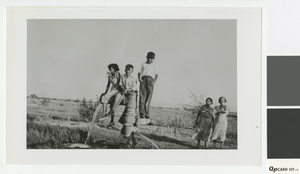
Photograph of children gathered by an artesian well near Tule Springs, circa 1938
Date
Archival Collection
Description
(left to right) Celia Rivero, Johnny Weber and Alfonso Rivero gathered by a well near Tule Springs with Margarita Rivero and Maria Weber looking on.
Transcribed Notes: 'Attached sheet: Las Vegas Review-Journal, The Nevadan, 'Help Us Write History,' February 7, 1982 -- Source: Celia Munney, 870-0713, 6301 Garwood. Born 1926. l-r: 1. Celia Rivero, 2. Johnny Weber, 3. Alfonso Rivero, cousin, 4. Margarita Rivero, mother. Died 1974, 5. Maria (Chuey) Weber, aunt. Deceased. ca. 1938. Picture taken near Tule Springs. Had restaurant, Frank's Cafe, on First St. near Fremont (pres. parking for California Club). Frank Rivero had 3 restaurants: 1 behind present Mint; 2nd near Home Lumber site; and this one. Frank died in 1948. Had Mexican and American food. Made lunches for Boulder Dam crews. Has pictures and made appointment to see her 2-17-82, 3:30 pm. Elko Rooms next to Frank's Restaurant owned by an aunt you came to LV in 1917.'
Image
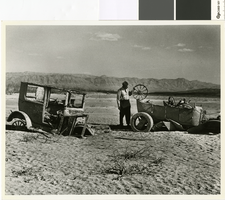
Photograph of two cars abandoned by their owners in St. Thomas, Nevada, April 11, 1948
Date
Archival Collection
Description
Remains of two cars, most likely near the remains of Hugh Lord's shop, in St Thomas, Nevada, when the town emerged from the waters of Lake Mead in 1945
Transcribed Notes: Bureau of Reclamation typed notes appended to back of photo: Boulder Canyon Project--Nevada--Region 3 St. Thomas, Nevada, was founded by the Mormons in 1855. In its heyday there were about 800 residents in the village. The "Main Street" was a part of the old Arrowhead Trail, which led from Salt Lake City, Utah to Los Angeles, California. In June 1938 the town was abandoned by its residents, which at that time were few in number because of the rising waters of Lake Mead that submerged the townsite. Photograph shows a closeup of two cars abandoned by their owners. Note the wide wooden wheel on the car to the right; also, the smaller wheel with wooden spokes. The wide wooden wheel was used as an "engine" to pump water, the belt being placed on this wooden wheel.
Image
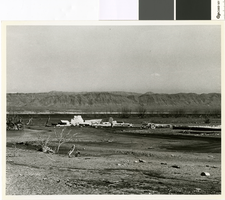
Photograph looking southeast through the remains of the post office in St. Thomas, Nevada, 1948
Date
Archival Collection
Description
The remains of the St. Thomas post office and Harry Gentry's store with Lake Mead in the background
Transcribed Notes: Bureau of Reclamation typed notes appended to back of photo: Boulder Canyon Project--Nevada--Region 3 St. Thomas, Nevada, was founded by the Mormons in 1855. In its heyday there were about 800 residents in the village. The "Main Street" was a part of the old Arrowhead Trail, which led from Salt Lake City, Utah to Los Angeles, California. In June 1938 the town was abandoned by its residents, which at that time were few in number because of the rising waters of Lake Mead that submerged the townsite. In 1945, after having been flooded for 7 years, receding waters of Lake Mead revealed St. Thomas much as it has appeared in former years. This photo was taken looking toward Mormon Mesa. The receding waters of the lake can be seen in the center of the photo.
Image
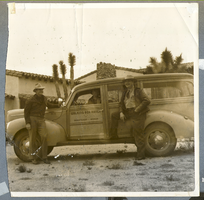
Vehicle with Walking Box Ranch, Searchlight, (Nev.) on the side. Rex Bell (left), Bill Froelich (right), and Rex Anthony Bell, Jr in the car: photographic print
Date
Archival Collection
Description
Bell Family Scrapbook scanning, Set 4, proofed 11.04.2010 Ford 'woodie' wagon with Walking Box Ranch, Searchlight, Nevada on the side outside of the ranch house at Walking Box Ranch. Rex Bell (George Francis Beldam) (left), Rex Anthony Bell, Jr (Toni Larbow Beldam) seated inside the vehicle and Bill Froelich on the right. Bill was a Ford dealer from Los Angeles, CA and a friend of the family's
Image
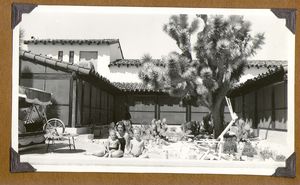
Clara and the Rex Anthony Bell, Jr (Toni Larbow Beldam) is seated on the right and George Francis Robert Bell is on the left on the patio at the ranch: photographic print
Date
Archival Collection
Description
Bell Family Scrapbook scanning, Set 4, proofed 11.04.2010 An unidentified woman with the two boys sitting by the pool at the Walkng Box Ranch. Rex Anthony Bell, Jr (Toni Larbow Beldam) is seated on the right and George Francis Robert Bell is on the left. The courtyard of the ranch house is visible in the background
Image
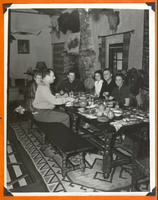
Rex Bell, Daisy Beldam, Bill Froelich, and three unidentified people at dinner party at Walking Box Ranch, Nevada: photographic print
Date
Archival Collection
Description
Bell Family Scrapbook scanning, Set 4, proofed 11.04.2010 Dinner party in the great room in the ranch house at Walking Box Ranch. From left side of table to right: Bill Froelich (Ford car dealer from Los Angeles), Grandmother Daisy Beldam (Rex Bell's mother), Rex Bell (George Francis Beldam)and three unidentified individuals
Image
